You’re a cruiser rider, and you like to travel, too, right? So your choice in bikes is a touring cruiser, one with a windscreen, saddlebags and passenger backrest. Only when you eye the heavyweight V-twin tourers, those of about 1,500cc and larger, you’re concerned about dealing with their sheer physical size and weight, and perhaps their price tags, too. So you scale your selection back to the middleweight touring cruisers, just as we have.
When you eyeball a story like this, with four similar bikes rolling across the page, you’re expecting a full-on comparison test, right? Well, this report is a bit different. Our criterion was to bring together a middleweight touring cruiser from each of the four major metric companies, and take them on the road. What complicates things, however, is that the term middleweight covers such a wide range in terms of displacement (we consider a middleweight to be larger than a 750 and smaller than a 1500) that the bikes cannot be compared directly. Among touring cruisers the only Suzuki that fell into the mix was the Boulevard C50T, an 805cc V-twin; at the other end of the spectrum we include Honda’s new VTX1300T, which we just featured in our March issue.
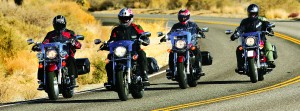
Filling the size gap in between is Kawasaki’s only middleweight tourer, the Vulcan 900 Classic LT, and Star’s V Star 1100 Silverado. If you’re wondering why we passed over the V Star 1300 Silverado, it’s because we already compared it with a touring accessorized Honda VTX1300 in our May 2007 issue. Besides, another angle to this 800/900/1100/1300 story is that we’re able to comment upon what the buyer gains or loses by going up the ladder in size and displacement. Let’s take them on a ride and see how they perform.
The Ride
Cruisers are all about sound, torque and feel, and touring is all about wind protection, long-distance comfort and carrying capacity, so we concentrated on those aspects. Each of our four middleweights came equipped with bolt-on leather saddlebags; the Suzuki’s were roomy, and closed with a simple twist latch. The Star’s were a bit smaller, with smaller openings that made it difficult to insert pre-bagged items. The Honda and Kawasaki bags were quite roomy, gaped wide, and made it easy to drop things in. The bags on these last three have convenient quick-release buckles hidden behind their traditional looking buckles; they open with a squeeze and close with a click.
With the bikes gathered in our parking lot we considered their styling and features. If you seek a custom look, well, each has one of those accursed fuel tanks with the flange along the bottom that immediately identifies it as a factory build. Honda and Kawasaki have had the decency to widen their frame downtubes and tuck their radiators between them so they don’t show from the sides; Suzuki has hung the C50T’s radiator right out front of the frame like a sore thumb. The Star is air-cooled, and dispenses with the whole messy business.
With its two-tone paint and white sidewall tires the Suzuki stands out, and the Honda’s glittery paint likewise grabs attention. With its black paint and abundant chrome our Star V Star 1100 Silverado offers a basic, classic look. The Kawasaki appears massive, yet subdued and understated, a solid piece.
For our test, four of us left Rider‘s drab but color-coordinated offices in Ventura, California, last February and headed east for the desert and Joshua Tree National Park. We would spend a day getting there mostly on freeways, and a day coming home on the back two-lane roads through towns with names like Lucerne Valley, Victorville and Apple Valley. We were two guys and two gals of various heights and weights, three seasoned riders and one newbie with less than a year of riding experience. Our sidebars give the facts on each bike; here we tell how they worked.
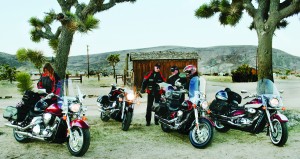
THE BIKES
Suzuki Boulevard C50T
Though it’s the smallest displacement bike in our test, the Boulevard offers a relatively spread-out seating position, but our shorter-inseam riders felt the Sooz was a little too stretched out. On the road we immediately felt more of the wind (and thus felt colder) on the Suzuki; its smaller windscreen provided the least protection in our group. The tank and floorboard configuration angled our boots upward and outward; as the windblast tried to blow our feet off the boards we had to maintain muscle tension, which was not relaxing.
With its lowest displacement the Suzuki had to be revved higher to start out, and by about 80 mph its remarkably smooth engine seemed to be straining. Its front disc brake was the weakest stopper in our group, and its rear drum brake (it was the only bike here so equipped) felt unusually spongy and weak.
For more information, see sidebar below.
Kawasaki Vulcan 900 Classic LT
Next largest in displacement, the Kawasaki 900 has the highest handlebar and lowest seat height (26.8 inches) and its spread-out seating position and wide handlebar give the impression of a much bigger bike. Its tall windscreen dictates that most riders will look through it, which can be a problem in rain or fog, but its protection was second only to the Honda. There’s an additional 2 inches of upward screen adjustment, but none of us wanted it. The engine is noticeably smooth, and the seat is wide and well shaped.
On its 16- and 15-inch wheels the Kawasaki did not feel as solidly planted in turns as the others, a sensation that could have been exaggerated by its wide handlebar. One rider noted, “It wanders quite a bit and picks its way around.” Note that each of these bikes has a five-speed transmission with heel-and-toe shifter, and each shifted well enough that we had no complaints.
For more information, see sidebar below.
Star V Star 1100 Silverado
If to you the authentic cruiser experience includes a certain staccato exhaust beat, a shudder when you get on the gas and that just right V-twin torquey power, you’ll love the V Star. We liked its responsive engine and great sound. The other bikes here generate “power pulses” to a lesser degree; in a sense they’re perhaps too smooth. We agreed that the Star had just the right degree of shake, yet it was never intrusive. It is carbureted, but did not take an inordinate amount of time to warm up.
Editor Mark Tuttle, who has a shorter 29-inch-inseam, preferred the Star and found its slight forward lean quite comfortable. Taller riders Donya and Bill found the Star’s floorboards placed too far rearward, cramping us. When we pushed back against the seat’s slope to stretch, it put our tushes to sleep. Though the second largest in displacement, in terms of ergonomics the Star felt like the smallest bike here by dint of its upthrust seat back and rearward-placed floorboards. At 677 pounds it was 17 pounds heavier than the Kawasaki.
The tilt of the windscreen caused a good deal of wind to come up from underneath, but not as much as on the Suzuki. The screen can be repositioned 2 inches higher, but that would not have helped.
If you’re a customizer who intends to do some creative welding and shaping with a torch, note that the Star is the only bike here with steel fenders. It alone also has dual front disc brakes, which delivered fine stopping power.
For more information, see sidebar below.
Honda VTX1300T
Our Mr. Big serves as a fine example of what you gain and lose by going up in displacement. First, this big bopper is going to set you back $10,999 in black (or $11,099 in silver or red). Without any encouragement from us, Honda further equipped this particular unit with $2,083.20 in accessories (see Honda sidebar) that bring it to more than 13 large. The next most expensive machine here, the Star, sells for $9,799 to $9,999, depending upon color.
Climb aboard the Honda and you may at first be disappointed that it’s carbureted, has a choke and is initially cold-blooded. From there on, however, it’s all cake. The bike is roomier and more stable than any other here. It’s smooth and unhurried; its engine is the only one that still feels understressed at 80 mph. It’s stable and doesn’t wander on the road. The Honda’s suspension is of noticeably higher quality; it absorbs the little bumps that the others pass along to the rider as twitches and patters. Its big windscreen delivers not only the best protection here, but also the quietest ride. The taller among us chose the Honda as most comfortable, but Mr. Tuttle found that for his size the seat forced him into a pocket that limited his ability to move around.
At 768 pounds the Honda outweighs the Star (the next heaviest bike) by 91 pounds! Keep in mind, however, that Honda had outfitted its entry with a number of accessories that increased its weight by an estimated 20 pounds. Jody, our newbie rider, had problems with the bike’s weight during turnarounds.
Conclusions
Near the end of our ride, when we’d all had the opportunity to ride each bike several times, we compared notes and voted on which made the most competent tourer. Our taller riders both chose the Honda first and Kawasaki second, as for us they were big, spread-out, comfortable platforms. Editor Tuttle was most comfortable on the Star and chose the Honda second. Jody, our newbie, felt best on the Kawasaki and liked the Suzuki, too, but shied away from the Honda because during slow maneuvers she found the weight intimidating. The other three of us shied away from the Suzuki because of its weak brakes. In summary, three of four chose the Honda and Kawasaki among their top two, and three of four mentioned the Suzuki and Star in their bottom two.
Regarding touring capabilities, Mr. Tuttle points out that the Star and Honda have cast wheels and tubeless tires. When the inevitable nail causes a flat, the tire can probably be plugged from the outside and you can soon be back on the road. The Suzuki and Kawasaki are equipped with wire wheels and tube-type tires; the tire must be removed to patch the tube, and none of these bikes has a centerstand. We’re talking a major service pickup here, with dollars and hours lost.
As a final caveat, the determining factors as to which bikes we preferred often had to do with ergonomics; and seats, bars, windscreens and floorboards are all easily changed. If your dealer allows a test ride, you may be able to exchange or replace certain items as a condition of sale.
SIDEBARS
Honda VTX1300T: The Big, New Guy
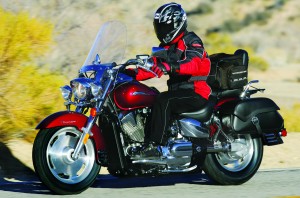
Though the VTX1300 has been around since 2003, this is the first year for the “T” (Tourer) version. It’s based upon the VTX13000R (for “retro”) that features deeply valanced fenders and cast wheels. The new model’s touring amenities include the non-adjustable windscreen, a pair of 24-liter leather saddlebags, the chromed passenger backrest with pad and chromed “Tourer” badge on the front fender. These items (other than the badge) have been in the Honda catalog and may be retrofitted to your existing VTX1300.
The largest bike in our test, the Honda displaces 1,312cc from its liquid-cooled, 52-degree V-twin engine. It actuates three valves and fires two spark plugs per cylinder, and has a compression ratio of 9.2:1. Though this may be the age of high technology, Honda has chosen to provide this model with a single 38mm carburetor rather than fuel injection. It puts its power to the ground through a driveshaft.
The engine offers bore and stroke dimensions of 89.5 x 104.3mm, and with a long stroke predictably it’s a torquey motor. The model we dyno tested last year (this year’s engine is mechanically unchanged) delivered 57.8 horsepower to the rear wheel at 5,000 rpm, with an impressive 71.4 lb-ft of torque at 3,000 rpm. A single-pin crankshaft produces some throbbing as the revs build, yet dual two-axis primary counter- balancers keep the vibes in check. None of our touring cruisers is equipped with a tachometer, so that’s as much as we can say about engine rpm.
A tube-steel frame ties together the 41mm fork and dual, chromed shock absorbers; its ride quality was impressive. With a 65.7-inch wheelbase and rake/trail figures of 32 degrees/5.7 inches this baby turns like a freighter, but provides great straight-line stability. The seat is relatively high at 27.4 inches. Squeezing the single front disc brake is a two-piston caliper, with a one-piston caliper in the rear; braking was adequate. The Honda carries 4.8 gallons of fuel and on our trip turned 38.9 mpg; it proved the thirstiest in our group.
Though we did not request it, this bike was outfitted with a long list of Honda Genuine Accessories including a digital audio system, luggage rack with grab rails, a light bar, heated grips, fender trim and various other chromed items to the tune of more than $2,000.
Kawasaki Vulcan 900 Classic LT: Big Bike/Small Package
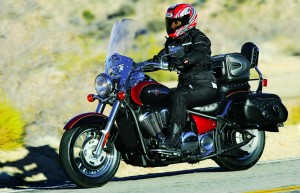
Introduced for 2006, the 900 Vulcan’s liquid-cooled, 55-degree V-twin engine offers four valves per cylinder actuated by single overhead cams. The rounded cylinder barrels and attractive new heads present a more classic look, and it has a bore and stroke of 88.0 x 74.2mm. At 903cc it displaces 98cc more than the old Vulcan 800 model it replaces. With a single-pin crank Kawasaki saw fit to equip the Vulcan with a gear-driven counterbalancer to hold the vibes in check.
The 900 is a completely new motorcycle, and utilizes belt final drive rather than its predecessor’s chain, or a driveshaft like the other machines in our test. A belt is lighter, quieter, requires infrequent adjustment and no lubrication. It’s also much more efficient than a driveshaft, transmitting more of the engine’s power to the ground because it gives up less in friction losses.
Shootin’ the juice is a pair of 34mm throttle-body fuel injectors that are equipped with ECU-controlled sub-throttles designed to deliver more precise fuel metering. Compression ratio is 9.5:1.
With a 64.8-inch wheelbase and rake/trail figures of 32 degrees/6.3 inches it has (like the other bikes in our test) big-bike dimensions though it’s “only” a 900. Its 41mm fork provides a generous 5.9 inches of travel, and its Uni-Trak shock has 4.1 inches. Its ride is acceptably plush, yet nothing here touches the Honda for ride quality. It’s all held together by a double-cradle frame and triangulated swingarm. At each end it’s equipped with a disc brake and two-piston caliper, which provided more than adequate braking.
As the second smallest machine here in terms of displacement, the Kawasaki was the second lightest at 660 pounds wet. Despite its weight, the Vulcan has the feel and presence of a big motorcycle and was easy to spread out upon. It carries 5.3 gallons of fuel, and its 43.7 mpg was right in the ballpark with two of the other three machines here.
Color selection includes three two-tone choices: Candy Cardinal Red/Metallic Diablo Black, Luminous Polaris Blue/Atomic Silver, and finally Pearl Crystal White/ Metallic Titanium.
Suzuki Boulevard C50T: Long Time Runner
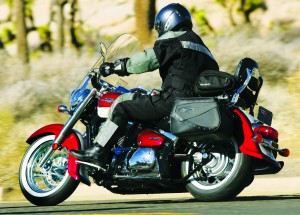
Back in 1986, Suzuki introduced a new small cruiser it called the VS700 Intruder; it grew in size to become an 805cc with a bore and stroke of 83.0 x 74.4mm. By 2004 Suzuki had restyled some of these 45-degree V-twin models under the names Volusia and Marauder. More recently it dropped the Intruder name entirely and has come to refer to its entire cruiser line as the Boulevards.
In an attempt to Americanize its cruiser model designations, Suzuki also began listing them in cubic-inch rather than cubic-centimeter displacements. To understand the nomenclature, for example, C50T designates a Custom with a 50-cubic-inch engine and Touring equipment. By the way, that liquid-cooled, 45-degree, 50-cube powerplant today has the same bore-and-stroke dimensions as the early 805cc engines, which by now are well proven. Because its crankpins are offset 45 degrees the Suzuki engine runs more smoothly than a single-crankpin engine and thus does not require counterbalancers. Electronic fuel injection and four valves per cylinder, with a compression ratio of 9.4:1, give it clean running and decent fuel economy. Power is transferred to the rear wheel via a driveshaft. Our test bike carried 4.1 gallons of fuel, and turned 43.2 mpg.
The smallest displacement bike in our test, the Suzuki Boulevard C50T is also the lightest at 632 pounds wet. Nevertheless, its 65.2-inch wheelbase is 1.7 inches longer than that of a Harley Electra Glide, so it retains some presence. With a 33-degree rake the bike is surprisingly light and easy in the steering department. Seat height is 27.6 inches, and the passenger seat can be easily removed to accentuate the clean rear fender look. It utilizes a cradle-type steel frame with a non-adjustable fork and single rear shock with seven-way preload adjustment.
At a mere $7,999 Suzuki is sure to sell a boatload of its C50Ts. If the red/white color (new for 2008) of our test bike is a bit too intense for you, the C50T is also available in black.
Star V Star 1100 Silverado: Back in Black
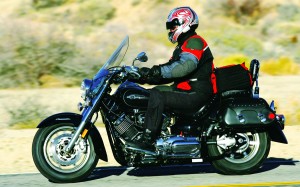
During the first great metric cruiser boom, Yamaha introduced an air-cooled V-twin in 1981 it called the Virago. Over the years the line proliferated and it became available in a variety of sizes including an 1100. These machines carried the Yamaha cruiser banner for nearly two decades, and as recently as 1998 the Virago 1100 was still going strong with its air-cooled, 1,063cc engine, driveshaft and cast wheels. For the next year Yamaha introduced its new V Star 1100 and ran both it and the Virago that year, but finally retired the old gal (“virago” means a strong or violent woman) after the ’99 model year.
Curiously enough, once you look past its completely restyled cylinders the V Star 1100’s engine is essentially the tried-and-true Virago’s, still an air-cooled, 75-degree V-twin with bore-and-stroke figures of 95.0 x 75.0mm, SOHC and two valves per cylinder; even the compression ratio is still the same at 8.3:1. It utilizes a set of 37mm Mikuni carburetors, there’s still a driveshaft to herd those ponies to the pavement, and the V Star 1100 Silverado carries cast wheels.
Yamaha has since come to designate its cruiser line as Star motorcycles, and a Silverado model in any size designates a tourer with bags, screen and backrest. At base on the V Star 1100 is a double-cradle steel frame with a hidden rear shock with 4.5 inches of wheel travel. Its fork offers 5.5 inches of travel, and together they give it a well-controlled ride that is short of plush. Wheelbase is a long 64.8 inches, and the 33-degree rake provides rather lazy turning. Still, bikes of this size are more oriented toward straight-line stability and that the 1100 delivers in spades. With its 28-inch seat height, only our art director Jody wished the bike were lower to the ground.
We filled its tank with 4.5 gallons of fuel, and on the trip the Silverado averaged 42.3 miles per gallon. The only change for 2008 is that the seat, backrest and saddlebags are now studded for more of a classic look. Too subdued for you in basic black for $9,999? The Candy Red model is available for $9,799.
Want more? Check out the full Rider 2008 Honda VTX1300T motorcycle review.

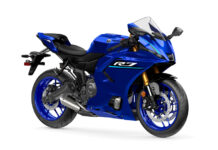

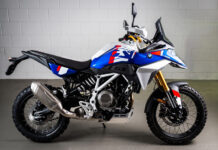
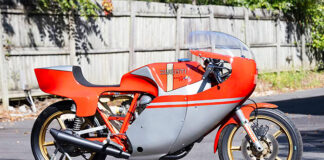
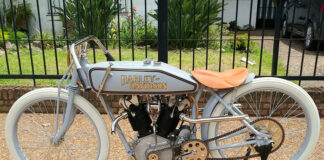
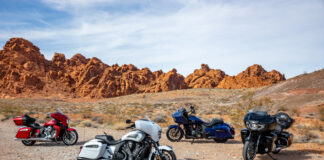

good review but I like the C50 never had trouble with my feet blowing off the floor boards I always rid relaxed. I like the wind blowing up from under the wind screen on a hot day it feels great the only thing I have to tuck my beard in as it blows it up in my face. As far as flat tires I had tubeless tires that I had to get replaced because of where the nail went in, were as the tub tire could be fixed. As for towing charges get CAA or AAA gold good for any thing you drive or ride , best money I spent , a must have for belt drive, I will never get another belt drive.